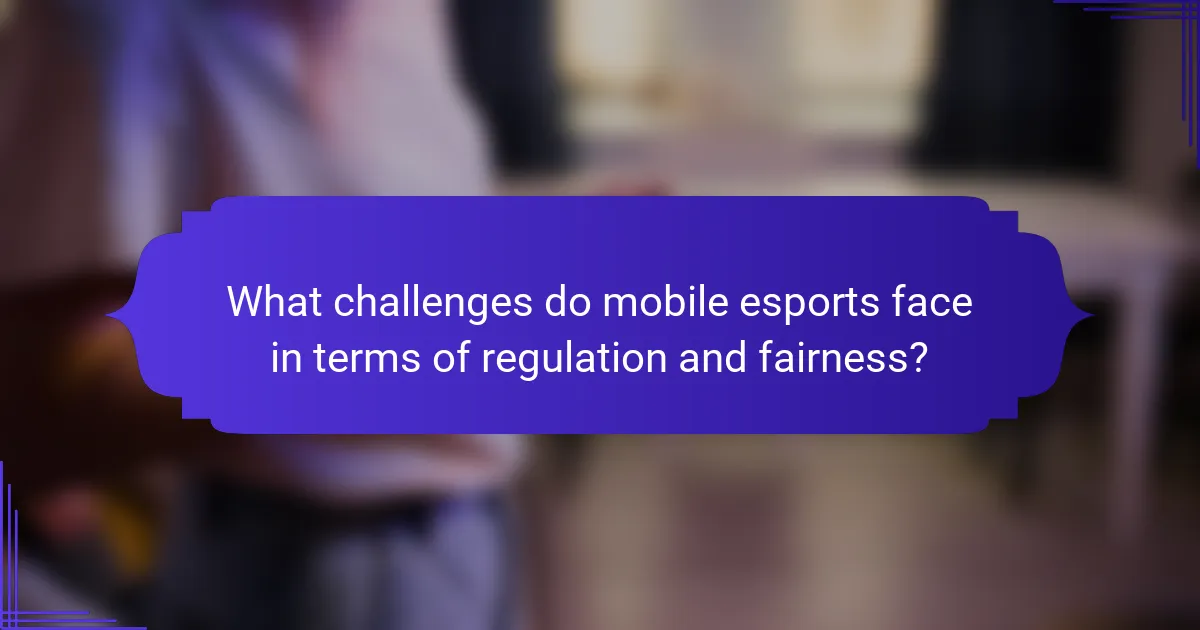Mobile esports are rapidly expanding, driven by smartphone accessibility, improved game quality, and community engagement. The rise of 5G technology enhances gameplay experiences, while brand partnerships boost audience interaction. Competitive tournaments foster player participation and create a dynamic ecosystem. However, challenges in regulation and fairness need addressing to ensure trust and integrity in this growing industry.

What are the key growth factors driving mobile esports in 2025?
Mobile esports will grow in 2025 due to increased smartphone accessibility, enhanced game quality, and robust community support. The rise of 5G technology will improve connectivity, enabling seamless gameplay. Additionally, partnerships with brands and influencers will drive engagement, expanding the audience. Competitive tournaments will attract more players, creating a vibrant ecosystem.
How do technological advancements impact mobile esports?
Technological advancements significantly enhance mobile esports by improving gameplay quality and accessibility. Innovations in mobile hardware, such as faster processors and better graphics, allow for more immersive experiences. Enhanced internet connectivity, including 5G networks, reduces latency, enabling smoother online competitions. Additionally, advancements in game development tools facilitate the creation of more engaging and dynamic games. As a result, these factors contribute to a growing player base and increased community engagement in mobile esports.
What role do mobile gaming platforms play in the growth of esports?
Mobile gaming platforms significantly contribute to the growth of esports by increasing accessibility and fostering community engagement. They allow players to participate in competitive gaming from anywhere, broadening the player base. Mobile esports events attract large audiences, driving sponsorship and investment. The unique attribute of mobile gaming is its ability to reach diverse demographics, including those who may not have access to traditional gaming setups. As a result, mobile esports are becoming a vital part of the overall esports ecosystem.
How does the rise of 5G influence mobile esports participation?
The rise of 5G significantly enhances mobile esports participation by providing faster speeds and lower latency. Players experience seamless gameplay and improved responsiveness, which fosters competitive dynamics. 5G’s capacity supports larger multiplayer environments, allowing for richer community engagement. As a result, more players are drawn to mobile esports, expanding the overall audience and participation rates.
Which demographics are most engaged with mobile esports?
The most engaged demographics in mobile esports are typically younger audiences aged 18-34. This group shows a high level of participation and interest in competitive gaming on mobile platforms. According to recent studies, 70% of mobile esports players fall within this age range, highlighting their significant role in driving the growth of the mobile esports community. Additionally, male players constitute a larger portion, but female engagement is steadily increasing, reflecting a broadening appeal of mobile esports across genders.
What are the economic implications of mobile esports growth?
The economic implications of mobile esports growth are significant, impacting various sectors. Increased participation leads to higher revenue through in-game purchases and advertising. Mobile esports also drive job creation in areas like event management and content creation. Furthermore, the rise of mobile esports fosters investment in technology and infrastructure, enhancing connectivity and accessibility. As a result, local economies benefit from increased tourism and consumer spending during esports events.

How does community engagement shape the mobile esports landscape?
Community engagement significantly shapes the mobile esports landscape by fostering player loyalty and enhancing competitive dynamics. Active communities create a sense of belonging, which drives participation and investment in games. Engaged players often share strategies, host tournaments, and promote titles, leading to increased visibility and growth. For example, community-driven events can attract sponsorships, elevating the esports scene. Additionally, feedback from players helps developers refine games, ensuring they meet player expectations and maintain relevance. This symbiotic relationship between community engagement and the mobile esports ecosystem is crucial for sustained growth and innovation.
What are the primary platforms for community interaction in mobile esports?
The primary platforms for community interaction in mobile esports include Discord, Twitch, Facebook Gaming, and in-game chat systems. These platforms facilitate communication, streaming, and social engagement among players and fans. Discord serves as a hub for community discussions, while Twitch offers live streaming and viewer interaction. Facebook Gaming integrates social networking with gaming, enhancing community connectivity. In-game chat systems allow real-time communication during matches, fostering teamwork and strategy.
How do social media and streaming services enhance community involvement?
Social media and streaming services significantly enhance community involvement in mobile esports by fostering connections and engagement. These platforms facilitate real-time interactions among players and fans, creating a vibrant community atmosphere.
Streaming services allow players to showcase their skills, attracting viewers who can engage through chat and social media. This interaction builds a sense of belonging and encourages participation in tournaments and events.
Social media amplifies this effect by enabling players to share achievements, strategies, and experiences. Hashtags and dedicated groups create spaces for discussions and collaborations, further solidifying community ties.
Additionally, these platforms provide access to diverse content, from tutorials to live events, enriching the community’s knowledge and involvement in mobile esports.
What events foster community engagement in mobile esports?
Events that foster community engagement in mobile esports include tournaments, live-streaming sessions, community challenges, and social media campaigns. These activities create interaction opportunities, enhance player visibility, and build connections among participants. Tournaments often feature competitive dynamics that encourage teamwork and skill development. Live-streaming sessions allow fans to engage with players directly, fostering loyalty. Community challenges promote collaboration and creativity, while social media campaigns keep the community informed and involved. Together, these events strengthen the mobile esports ecosystem and enhance user experience.
How do community-driven initiatives influence game development?
Community-driven initiatives significantly shape game development by fostering player engagement and feedback. These initiatives create platforms for players to influence game mechanics and design, enhancing user satisfaction. For example, mobile esports communities often organize tournaments that highlight competitive dynamics and attract developers’ attention. As a result, developers prioritize community input to refine gameplay and features. This collaboration enhances the gaming experience, driving growth in the mobile esports sector. Additionally, unique community events can lead to rare game updates, further engaging players and sustaining interest.

What competitive dynamics define mobile esports tournaments?
Mobile esports tournaments are defined by competitive dynamics that include player skill, team strategies, and audience engagement. These factors contribute to the overall growth of the mobile esports ecosystem.
Player skill remains a root attribute, as top performers consistently influence tournament outcomes. Team strategies, which are unique attributes, vary across different games and can dictate the flow of matches. Audience engagement is a rare attribute that enhances the viewing experience, often driving sponsorship and investment.
As a result, these dynamics create a vibrant competitive landscape that attracts both players and spectators, fostering community and increasing the popularity of mobile esports.
How do tournament structures differ from traditional esports?
Tournament structures in mobile esports often emphasize shorter match formats and rapid progression, differing from traditional esports which may feature longer, more complex formats. Mobile esports typically prioritise accessibility and speed, attracting a wider audience. For example, tournaments often include knockout stages or round-robin formats that allow for quick eliminations and fast-paced gameplay. This structure enhances viewer engagement and caters to mobile users’ preferences for shorter gaming sessions. Additionally, mobile esports tournaments frequently integrate community-driven elements, such as fan voting and participation, which are less common in traditional formats.
What are the most popular mobile esports titles in competitive play?
The most popular mobile esports titles in competitive play include League of Legends: Wild Rift, PUBG Mobile, Free Fire, Arena of Valor, and Call of Duty: Mobile. These games engage large communities and feature dynamic competitive scenes.
League of Legends: Wild Rift offers strategic gameplay with a focus on teamwork. PUBG Mobile emphasizes battle royale mechanics, attracting players with its survival elements. Free Fire stands out for its fast-paced matches and accessibility. Arena of Valor showcases intense multiplayer online battle arena (MOBA) action. Call of Duty: Mobile combines classic FPS elements with mobile-friendly controls.
These titles contribute to the growth of mobile esports by fostering community engagement and providing diverse competitive dynamics.
How do team formations and player roles vary in mobile esports?
Team formations and player roles in mobile esports vary significantly based on game mechanics and strategic objectives. Various formations, such as aggressive, defensive, or balanced setups, influence how teams approach matches.
Player roles are typically categorized into positions like support, damage dealer, and tank, each contributing distinct strengths. For example, a support player focuses on healing and aiding teammates, while a damage dealer maximizes offensive output.
The adaptability of formations and roles allows teams to respond to opponents’ strategies, enhancing competitive dynamics. Unique attributes, such as player synergy and communication styles, further differentiate team strategies in mobile esports.
As mobile esports continue to grow, understanding these variations becomes crucial for teams aiming to optimize performance and engage with their communities effectively.
What strategies do successful teams employ in mobile esports competitions?
Successful teams in mobile esports employ strategies focusing on communication, collaboration, and adaptability. Effective communication ensures that all team members understand tactics and roles. Collaboration fosters synergy, allowing players to leverage each other’s strengths. Adaptability enables teams to adjust strategies in real-time based on opponents’ actions. Additionally, practice and analysis of gameplay contribute to improved performance. These factors are essential for success in the competitive mobile esports landscape.

Which unique attributes distinguish successful mobile esports titles?
Unique attributes that distinguish successful mobile esports titles include innovative gameplay mechanics, strong community support, cross-platform compatibility, and engaging monetization strategies. These elements foster player retention and competitive dynamics. For instance, titles like PUBG Mobile and Arena of Valor showcase unique attributes such as regular content updates and robust esports ecosystems, enhancing their appeal.
What gameplay mechanics contribute to the popularity of mobile esports games?
Mobile esports games thrive due to engaging gameplay mechanics that enhance competitiveness and community involvement. Key mechanics include accessibility, fast-paced action, and social features.
Accessibility allows players to join easily, as many mobile esports titles are free-to-play. Fast-paced action keeps players engaged, enabling quick matches that fit into busy schedules. Social features, such as team play and in-game chat, foster community connections, enhancing the overall experience.
Additionally, regular updates and events keep the gameplay fresh, encouraging ongoing participation. These elements collectively contribute to the growing popularity of mobile esports games.
How do monetization strategies impact the success of mobile esports titles?
Monetization strategies significantly influence the success of mobile esports titles by shaping revenue streams and player experiences. Effective strategies, such as in-game purchases and sponsorships, enhance community engagement and support competitive dynamics. For example, titles that offer cosmetic upgrades often see higher player retention, fostering a dedicated user base. Additionally, diverse revenue models attract more developers, contributing to market growth. As a result, successful monetization not only boosts profitability but also enriches the overall gaming ecosystem.
What differentiates mobile esports from console and PC esports?
Mobile esports differ from console and PC esports primarily due to accessibility, player demographics, and game design. Mobile esports attract a broader audience since smartphones are widely available, enabling casual gamers to participate.
Competitive dynamics in mobile esports emphasize quick matches suited for on-the-go play, contrasting with the longer, more strategic sessions typical in console and PC games. Community engagement is often driven by social media and streaming platforms, fostering a unique culture around mobile gaming.
Additionally, mobile esports frequently feature games designed for shorter sessions and simplified controls, appealing to players who may not have extensive gaming experience. As a result, this segment is rapidly growing, with mobile titles like PUBG Mobile and Clash Royale leading in competitive play.

What challenges do mobile esports face in terms of regulation and fairness?
Mobile esports face significant challenges in regulation and fairness due to the lack of standardized rules across regions. Different countries impose varying regulations, creating inconsistencies in competitive integrity. Additionally, issues such as cheating and the use of unauthorized software further complicate fair play. The rapid growth of mobile esports has outpaced regulatory frameworks, leading to disputes over player eligibility and tournament governance. As a result, establishing a unified regulatory body is essential for ensuring fairness and maintaining player trust in the ecosystem.
How do cheating and fairness issues affect mobile esports competitions?
Cheating and fairness issues significantly undermine mobile esports competitions by eroding trust and integrity. These problems can lead to player disengagement and a decline in audience interest. Cheating disrupts competitive balance, making it difficult for legitimate players to succeed. As a result, organizers must implement strict regulations and monitoring systems to maintain fair play and enhance community trust. Addressing these issues is crucial for sustainable growth in the mobile esports ecosystem.
What regulatory frameworks are emerging for mobile esports?
Emerging regulatory frameworks for mobile esports focus on player protection, fair competition, and data privacy. Governments and organizations are developing guidelines to ensure integrity in tournaments. For example, the International Esports Federation is working on standards to govern player contracts and event operations. As mobile esports grows, compliance with these regulations will be crucial for sustainable development.
How do developers address balance and fairness in mobile esports?
Developers address balance and fairness in mobile esports by implementing rigorous matchmaking systems and regular game updates. These systems analyze player skill levels to create equitable matchups, reducing frustration and enhancing the competitive experience. Additionally, developers monitor gameplay data to identify and rectify imbalances, ensuring that no single character or strategy dominates. Community feedback plays a crucial role in these adjustments, fostering engagement and trust among players. Regular tournaments and events further promote fairness by adhering to standardized rules and formats, encouraging a level playing field.

What best practices can enhance participation in mobile esports?
To enhance participation in mobile esports, focus on community engagement, accessibility, and competitive incentives. Creating inclusive events fosters a diverse player base. Providing easy access to tournaments encourages wider participation. Offering rewards and recognition boosts player motivation and loyalty.
How can players improve their skills in mobile esports?
Players can improve their skills in mobile esports through consistent practice, strategic analysis, and community engagement. Regularly playing games enhances reflexes and decision-making. Analyzing gameplay footage helps identify weaknesses and optimize strategies. Engaging with the community fosters learning through shared experiences and tips. Utilizing training tools and participating in tournaments further accelerates skill development.
What resources are available for aspiring mobile esports professionals?
Aspiring mobile esports professionals can access various resources to enhance their skills and knowledge. These include online courses, industry forums, coaching programs, and competitive leagues.
Online platforms like Coursera and Udemy offer courses on game strategy and streaming techniques. Industry forums such as Reddit and Discord provide community engagement and networking opportunities. Coaching programs connect players with experienced mentors who provide personalized guidance. Competitive leagues, including ESL Mobile and PUBG Mobile Pro League, offer platforms for practical experience and visibility.
These resources collectively support skill development and community engagement in the rapidly growing mobile esports sector.
What common mistakes should players avoid in mobile esports?
Players should avoid common mistakes like neglecting practice, underestimating teamwork, and ignoring game updates. Focusing solely on personal skill can hinder overall performance. Many players overlook the importance of communication, which is crucial in mobile esports. Additionally, failing to analyze opponents can lead to repeated mistakes. Understanding the competitive landscape enhances strategy and adaptability.
